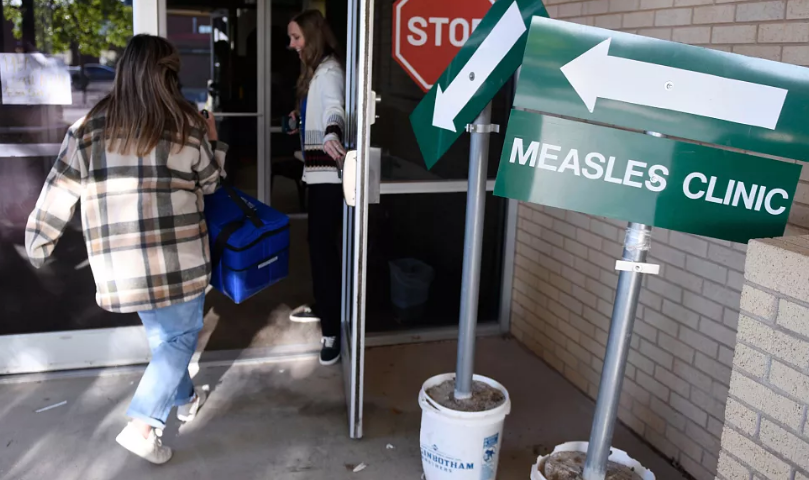Health
U.S. Measles Cases Hit 30-Year High Amid Ongoing Outbreaks in 14 States

Health
New Review Finds Plant-Based Diets Safe for Children When Properly Supplemented

A major scientific review has concluded that children can safely follow vegetarian or vegan diets, provided they receive the right supplements or consume foods fortified with essential nutrients. The findings, published in Critical Reviews in Food Science and Nutrition, assessed how plant-based eating patterns affect growth, health, and nutrient intake among young people.
Researchers examined data from nearly 49,000 children and teenagers across 18 countries, comparing those who followed vegetarian, vegan, and omnivorous diets. The study’s lead author, Monica Dinu of the University of Florence, said the results show that plant-based diets can support healthy development when they are carefully planned. She stressed that key nutrients must be monitored to avoid deficiencies.
The review found that vegetarian children typically consumed more fibre, iron, folate, vitamin C, and magnesium than their meat-eating peers. However, their intake of energy, protein, fat, vitamin B12, vitamin D, and zinc was lower. Similar patterns were observed among vegan children, whose calcium intake was notably low. According to the researchers, vitamin B12 was consistently inadequate without fortified foods or supplements.
Study co-author Jeannette Beasley of New York University noted that children on vegetarian and vegan diets may require supplementation for nutrients such as vitamin B12, calcium, iodine, and zinc. These gaps were most evident among vegans, who avoid all animal products, including dairy and eggs.
Despite these shortcomings, the review identified several health advantages linked to plant-based diets. Both vegetarian and vegan children showed signs of stronger cardiovascular health compared with omnivores. The study reported lower cholesterol levels, including reduced low-density lipoprotein (LDL) cholesterol, which is associated with a higher risk of heart disease. Vegetarian children were generally slightly shorter and leaner, with lower body mass index and fat mass, though these differences remained within healthy ranges.
The authors cautioned that interpreting the results has limitations. It remains difficult to determine whether the diets themselves caused the observed health outcomes. Families adopting plant-based eating patterns may also differ in lifestyle or socioeconomic factors that influence children’s health.
Given the increasing number of households adopting plant-based diets for ethical, environmental, or health reasons, researchers urged parents to seek guidance from paediatricians or dieticians when planning meals for children. They also called for more official recommendations to help families ensure adequate nutrient intake during key stages of growth.
Dinu said the team hopes the findings will help families better understand the potential benefits and risks associated with plant-based diets, enabling them to make informed decisions that support children’s long-term wellbeing.
Health
Sperm Donor with Cancer-Causing Mutation Fathers Nearly 200 Children Across Europe

A sperm donor carrying a rare cancer-causing genetic mutation has fathered nearly 200 children across Europe, according to an investigation led by the European Broadcasting Union, involving 14 public service broadcasters. The man, who appeared healthy and passed standard screening, donated sperm for approximately 17 years while he was a student.
The mutation, found in the TP53 gene, increases the risk of cells becoming cancerous. Children who inherit the mutation develop Li Fraumeni syndrome, a disorder associated with up to a 90 percent lifetime risk of cancer. Some donor-conceived children have already died, and many more are expected to develop cancer in the future.
Doctors first identified the risk this year after discovering 23 children carrying the mutation among 67 known cases, 10 of whom had already been diagnosed with cancer. Investigators reported that the donor’s sperm was used to conceive at least 197 children in 14 countries, though the actual number may be higher. Children have been born in Denmark, Belgium, Spain, Greece, and Germany, with additional recipients in Ireland, Poland, Albania, Kosovo, and Sweden. A small number of women from the United Kingdom were also treated at clinics in Denmark, according to Peter Thompson, chief executive of the UK’s Human Fertilisation and Embryology Authority.
Denmark’s European Sperm Bank, which supplied the samples, admitted the sperm was overused and expressed “deepest sympathy” to affected families. The bank said the mutation could not have been detected through routine screening and immediately blocked the donor once the problem was discovered.
Experts have described the case as both a regulatory failure and an extraordinary coincidence. Jackson Kirkman-Brown, a professor at the University of Birmingham, noted that detecting new mutations in sperm is difficult and that the core issue lies in insufficient monitoring of how often a single donor’s sperm is used. Clare Turnbull from the UK Institute of Cancer Research said the situation reflects a highly unusual combination: a donor carrying a rare mutation and that same sperm being used to create a large number of children. She added that the mutation likely arose in the donor’s testes and spread among sperm cells, a phenomenon known as selfish spermatogonial selection.
The investigation has also highlighted differences in European regulations on sperm donation. Family and child limits vary widely: in Cyprus, a donor may contribute to only one child, while France, Greece, Italy, and Poland allow up to 10. Denmark limits donations to 12 families, and Sweden and Norway to six families. Some countries maintain anonymous donations, though disclosure may occur in cases of severe health conditions.
Euronews Health has contacted the European Sperm Bank for comment but has not yet received a response. The case has renewed calls from experts for tighter international oversight of sperm donation to prevent similar incidents in the future.
Health
AI Note-Taking Tool Gives European Clinicians More Time With Patients, Study Finds

A new analysis from Swedish firm Tandem Health suggests that automated note-taking technology is reducing paperwork for clinicians across Europe and allowing them to spend more meaningful time with patients.
The company reviewed more than 375,000 medical notes produced with its AI scribe, a tool now used by nearly 1,300 clinicians in 11 European countries, including the UK, France and Spain. The findings indicate that the technology shortened the average time spent writing notes from 6.69 minutes to 4.71 minutes — a 29% drop.
Tandem Health also surveyed 177 clinicians, ranging from GPs and surgeons to psychologists and nurses. Many said the reduction in administrative work allowed them to feel more attentive during consultations, while some reported a noticeable decrease in stress linked to routine documentation.
Health workforce fatigue remains a growing concern in Europe. An international survey published earlier this year found that administrative overload is a major factor behind burnout among primary care doctors. In the UK, 28% of GPs who reported burnout said excessive paperwork was the main cause. In Switzerland, the proportion rose to 65%.
Tandem Health CEO Lukas Saari said the results highlight how digital tools could support overstretched services. “For European healthcare systems facing acute workforce shortages and rising costs, that capacity gain could make a real difference at scale, addressing wait times, clinician burnout and care access,” he said.
The company stressed that much of the existing research on AI scribes comes from the United States, where healthcare structures differ significantly from those in Europe. Tandem Health’s scribe is classified as a medical device under EU rules, and the firm says more regional evidence is necessary as adoption grows.
Dr Artin Entezarjou, head of medical operations at Tandem Health, said the data offers insight for policymakers and health leaders examining new ways to address persistent staffing pressures. He noted that European systems must understand how such tools function in their own clinical environments to shape appropriate guidance and investment decisions.
Supporters of the technology argue that even modest efficiency gains could help reduce appointment backlogs and ease strain on health workers. Many clinicians in the survey said the extra time and reduced cognitive load improved the quality of their patient interactions, which they viewed as a central benefit of the scribe.
The findings arrive as hospitals and primary care networks across Europe continue to test digital tools that could take on repetitive administrative duties. Tandem Health says demand for its scribe has risen sharply over the past year as more clinicians explore ways to streamline paperwork without compromising record accuracy.
The company plans to expand data collection to assess long-term effects on patient flow, clinical workload and staff retention.
-

 Entertainment1 year ago
Entertainment1 year agoMeta Acquires Tilda Swinton VR Doc ‘Impulse: Playing With Reality’
-

 Business2 years ago
Business2 years agoSaudi Arabia’s Model for Sustainable Aviation Practices
-

 Business2 years ago
Business2 years agoRecent Developments in Small Business Taxes
-

 Home Improvement1 year ago
Home Improvement1 year agoEffective Drain Cleaning: A Key to a Healthy Plumbing System
-

 Politics2 years ago
Politics2 years agoWho was Ebrahim Raisi and his status in Iranian Politics?
-

 Business1 year ago
Business1 year agoCarrectly: Revolutionizing Car Care in Chicago
-

 Sports1 year ago
Sports1 year agoKeely Hodgkinson Wins Britain’s First Athletics Gold at Paris Olympics in 800m
-

 Business1 year ago
Business1 year agoSaudi Arabia: Foreign Direct Investment Rises by 5.6% in Q1




























